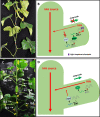Genetic regulation of shoot architecture in cucumber
- PMID: 34193859
- PMCID: PMC8245548
- DOI: 10.1038/s41438-021-00577-0
Genetic regulation of shoot architecture in cucumber
Abstract
Cucumber (Cucumis sativus L.) is an important vegetable crop species with great economic value. Shoot architecture determines the visual appearance of plants and has a strong impact on crop management and yield. Unlike most model plant species, cucumber undergoes vegetative growth and reproductive growth simultaneously, in which leaves are produced from the shoot apical meristem and flowers are generated from leaf axils, during the majority of its life, a feature representative of the Cucurbitaceae family. Despite substantial advances achieved in understanding the regulation of plant form in Arabidopsis thaliana, rice, and maize, our understanding of the mechanisms controlling shoot architecture in Cucurbitaceae crop species is still limited. In this review, we focus on recent progress on elucidating the genetic regulatory pathways underlying the determinant/indeterminant growth habit, leaf shape, branch outgrowth, tendril identity, and vine length determination in cucumber. We also discuss the potential of applying biotechnology tools and resources for the generation of ideal plant types with desired architectural features to improve cucumber productivity and cultivation efficiency.
Conflict of interest statement
The authors declare no competing interests.
Figures




Similar articles
-
CsLFY is required for shoot meristem maintenance via interaction with WUSCHEL in cucumber (Cucumis sativus).New Phytol. 2018 Apr;218(1):344-356. doi: 10.1111/nph.14954. Epub 2017 Dec 23. New Phytol. 2018. PMID: 29274285
-
Research Progress on the Leaf Morphology, Fruit Development and Plant Architecture of the Cucumber.Plants (Basel). 2022 Aug 16;11(16):2128. doi: 10.3390/plants11162128. Plants (Basel). 2022. PMID: 36015432 Free PMC article. Review.
-
HANABA TARANU regulates the shoot apical meristem and leaf development in cucumber (Cucumis sativus L.).J Exp Bot. 2015 Dec;66(22):7075-87. doi: 10.1093/jxb/erv409. Epub 2015 Aug 28. J Exp Bot. 2015. PMID: 26320238 Free PMC article.
-
Genetic Regulation of Shoot Architecture.Annu Rev Plant Biol. 2018 Apr 29;69:437-468. doi: 10.1146/annurev-arplant-042817-040422. Epub 2018 Mar 19. Annu Rev Plant Biol. 2018. PMID: 29553800 Review.
-
Morphological Characterization and Integrated Transcriptome and Proteome Analysis of Organ Development Defective 1 (odd1) Mutant in Cucumis sativus L.Int J Mol Sci. 2022 May 23;23(10):5843. doi: 10.3390/ijms23105843. Int J Mol Sci. 2022. PMID: 35628653 Free PMC article.
Cited by
-
A single nucleotide substitution introducing premature stop codon within CsTFL1 explains the determinate-2 phenotype in cucumber (Cucumis sativus L.).Sci Rep. 2024 Oct 25;14(1):25368. doi: 10.1038/s41598-024-76549-w. Sci Rep. 2024. PMID: 39455674 Free PMC article.
-
CsHLS1-CsSCL28 module regulates compact plant architecture in cucumber.Plant Biotechnol J. 2024 Jun;22(6):1724-1739. doi: 10.1111/pbi.14298. Epub 2024 Jan 23. Plant Biotechnol J. 2024. PMID: 38261466 Free PMC article.
-
Understanding the responses of tillering to 2,4-D isooctyl ester in Setaria viridis L.BMC Genomics. 2024 Jul 9;25(1):682. doi: 10.1186/s12864-024-10579-6. BMC Genomics. 2024. PMID: 38982341 Free PMC article.
-
Multifunctional Role of Cytokinin in Horticultural Crops.Int J Mol Sci. 2025 Jan 25;26(3):1037. doi: 10.3390/ijms26031037. Int J Mol Sci. 2025. PMID: 39940806 Free PMC article. Review.
-
Identification and characterization of long non-coding RNA (lncRNA) in wild and semi-wild cucumbers.BMC Plant Biol. 2025 Jun 3;25(1):748. doi: 10.1186/s12870-025-06752-y. BMC Plant Biol. 2025. PMID: 40457178 Free PMC article.
References
-
- Weberling, F. & Pankhurst. R. J. Morphology of Flowers and Inflorescences (Cambridge University Press, Cambridge, 1989).

